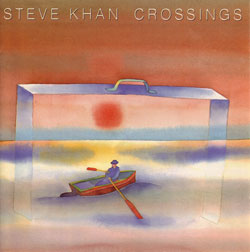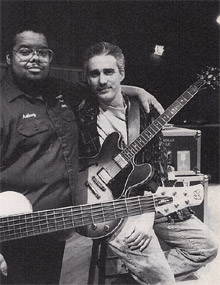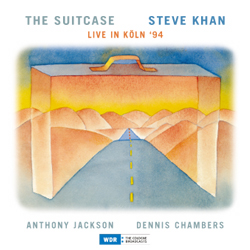Steve Khan's "What I'm Said" Lead sheet
Like so many of my tunes,
"What I'm Said" was composed solely around a 'groove,' an 'attitude,'
and that attitude comes from Dennis Chambers' interpretation
of the famous "Purdie Shuffle." This drum groove was, of course, made
famous by drummer, Bernard "Pretty" Purdie, and
I was lucky enough to have played with him when he played that particular
groove on Steely Dan's famous "Babylon Sisters" which
appeared on their "GAUCHO" recording. However, as my recording
"CROSSINGS"(Verve) was going to have a decidedly Latin flavor
to it, I knew that we would to have to blend that drum beat with a
percussive invention from Manolo Badrena. As the shuffle
groove is rooted in triplets, this can lead to playing some kind of
a Latin 6/8 feel against it and this is exactly what Manolo supplied
with his
brilliant chekeré part, and it added the exact flavor that I
was hoping for. However, as my recording
"CROSSINGS"(Verve) was going to have a decidedly Latin flavor
to it, I knew that we would to have to blend that drum beat with a
percussive invention from Manolo Badrena. As the shuffle
groove is rooted in triplets, this can lead to playing some kind of
a Latin 6/8 feel against it and this is exactly what Manolo supplied
with his
brilliant chekeré part, and it added the exact flavor that I
was hoping for.
The Intro, the [I] section, is obviously meant
to set the 'mood' and to reveal part of the harmonic intent of the tune.
I employed two lush guitar voicings and the simple use of lots of space.
The movement of the harmony is simply up a m3rd from Fm7(9)/Bb for 4
bars to Abm7(9)/Bb for 4 bars, with single-note lines from Anthony
Jackson's contrabass guitar in the open spaces. From a harmonic
perspective, the usage of the low, open E-string at the end of bars
4, 8, and 12 is especially effective in blurring the sense of harmony.
It was my original intention that "What I'm Said"
was to be yet another twist on a "blues" and so, as we arrive at [A],
you will see examples of this in how the harmony moves and how the piece
was structured. The simple dotted quarter to 8th-note rhythm continues
in the 1st bar of each two bar phrase, and the lines which respond employ
bits of dissonance mixed with rhythmic accents playing off of the triplet
rhythms. You can hear examples of this in bars 4; 7; and 12. At bar
8, I employ the sense of harmony you might expect to hear in a conventional
blues at bar 4. But here I use both the alteration of Bb7, adding the
#9 and #5 mid-bar and then, on beat 4, we play D/E(w/ the guitar's natural
harmonics) as it serves as the b5 substitute which moves us to our IV7(Eb7)
in bar 9.
Because Dennis' drum groove is so relentless, it
gives one the feeling that "something" is about to happen, and so the
melody at [A] is always building, just very quietly and with
subtlety. The sense of drama is added to when Anthony and I play unison
lines again in bars 12 and 16. Looking at the harmony, in bars 15-16,
I've used a V7 of V7 device with a C7(alt.) chord, and the last of the
two unison lines brings us to the [B] section. Again, from the
harmonic perspective, [B] is really intended to serve as the
area of the V7 chord in this very strange take on a blues. And you'll
see that we've landed on an area closest to F7, which is the V7 of
Bb.
However, for this section, there really are no lines per se as the
dotted quarter to 8th note rhythm played by the guitar and bass continues,
but
here Dennis is allowed to open-up and solo over the attitude of this
section. When we take the 2nd ending, and we finally land on an F#m7(9)/B
this serves as another b5 substitute to bring us back to Bb7 our center
for this tune. You will also notice that the number of bars loses its
symmetry because we added an extra bar for the hold simply because,
it just 'felt right.' At this point, both [A] and [B] are
repeated.
The solo format attempts to take advantage of both
the [I] and [A] sections with the great difference being
that Anthony and I have been freed-up to engage in an ongoing 'dialogue'
throughout what would be the guitar solo. So, a solo 'chorus' on this
tune really consists of the following structure: [C] [C] [D],
and on the recorded version, we played two choruses. The [C]
section mirrors the harmonic motion of [I], and the [D] section,
though like [A], has now become a 20-bar blues form. Of special
note is Anthony's incredible use of space, his choice of notes, and
the placement of dissonances at just the right moment. Again, he is
truly a one-of-a-kind musician!
When [D] is played for the last time, we go
back to [I] and play it one time, then [A] is played once
before we 'loop' letter [B] and Dennis simply solos until the
tune was faded. I suppose it should be noted that we stick to the rather
odd little 9-bar form of [B] for Dennis' soloing exploits. To
heighten the sense of drama, not that Dennis needed my help, I overdubbed
my Stratocaster doing volume pedals 'swells' of the long areas of harmony.
Usually, these are recorded direct into the board, and using a TC
Chorus so that the sonic color differs from my normal sound which
employs the Ibanez DCF-10, using its chorus sound, but with great
subtlety which is why I love it so much! To
heighten the sense of drama, not that Dennis needed my help, I overdubbed
my Stratocaster doing volume pedals 'swells' of the long areas of harmony.
Usually, these are recorded direct into the board, and using a TC
Chorus so that the sonic color differs from my normal sound which
employs the Ibanez DCF-10, using its chorus sound, but with great
subtlety which is why I love it so much!
It would be impossible to discuss this piece without
saying something, yet again, about the very special engineering talents
of James Farber. "CROSSINGS" probably represents, when all is
said and done, the recording with the greatest sonic beauty of all my
CDs. And this is, without question, due to the brilliance of James Farber.
Students of contemporary jazz recordings should be very familiar with
his name and his work as he has engineered 100s of titles over the past
several decades. For most of us, our choice in engineers is just like
choosing another musician, for that person is really that important.
James' sense of perspective and subtle usage of reverbs is very special
to him. I probably have to nudge him a little to add more reverb as
he tends to gravitate towards a vision of less, but we always work well
together and compromise along the way.
So, where does this title, born of exceptionally
fractured English come from? Well, my dear friend, keyboard player,
Clifford Carter said this once when we were somewhere together,
and it really made me laugh, so I wrote it down. I don't know why I
have this fascination for such things, but I do, and English is such
a great language to make fun of! At this time, with the world in the
state that it's in, I would like to take advantage of this forum and
wish everyone, who reads this, a greater sense of peace, calm and security
in their own neighborhoods and cities first; and then that this would
radiate and expand to their countries as a whole, out to their regions,
on to their continents, and then, perhaps, we can all come to a better
and greater understanding of one another. I know that it can seem hopeless
and impossible on any given day, but if we could each start from within
and just do one kind thing each day for someone, perhaps even a stranger,
then maybe, someday, this could be a better world. Like so many of you,
I would love to see an end to all the bitterness and violence that now
exists, and too, too close to us all. And that's "What I'm Said!!!"
Addendum: With the release in 2008 of "THE SUITCASE" a double live CD with Anthony Jackson and Dennis Chambers recorded in Köln, Germany originally for a WDR radio broadcast on May 17th, 1994, I believe that it becomes necessary to revisit the analysis pages related to the 9 original tunes which appear. Yes, for a song like this, which appeared on the original "CROSSINGS" recording from 1993, just 5 months had passed, but the performances you now hear represent the growth of the music through this 2-1/2 weeks of live playing and improvising. In this case, what you now hear on this CD will be much closer to the lead sheets you've been viewing since the launching of the website in September of 1998. In this case, what you now hear on this CD will be much closer to the lead sheets you've been viewing since the launching of the website in September of 1998.
I suppose if one can simply A-B the new 'live' version with the original version, it would become obvious that we are now playing the tune at a much more brisk pace. Many of the performances on the 'live' discs reveal this same thing. Another adjustment which I made for the 'live' version is that I felt the need to add 4 extra bars to the end of the solo form. The reason was simple, it just feels better that way. What also occurred during the tour was the fact that, during the last chorus of the solo, I stomped down on my Ibanez Tube Screamer and broke out a chorus of overdrive. This 'new' dimension, absent for many, many years, was hatched upon the insistence of Dennis Chambers. During our soundchecks, to alleviate the endless boredom of such routines, we would play tunes which we might not play during the evening, or just jam. And, at varying times, I would breakout my overdrive sound then. Early on in the tour, Dennis said to me, "Khan, you must be crazy! You have one of the great sounds in that zone as I've ever heard or played with. You have to do some of that during the gigs!!!" Well, after enough prodding, one night I did it - and after that, it stayed. But, there's something troubling to me that the audience seems to respond to that so easily. When that happens, it can create the tendency to over-use it. And to me, that's a most dangerous thing.
As it is throughout these 'live' performances, the time and imagination of both Anthony and Dennis is just beyond awe-inspiring. I would imagine that this simple statement will not escape anyone!!!
[Photo: David Tan. Anthony Jackson and Steve
at the "CROSSINGS" recording session in '93.]
|

